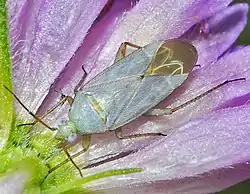Placochilus seladonicus
Placochilus seladonicus is a species of insects in the family Miridae, the plant bugs.[1]
| Placochilus seladonicus | |
|---|---|
 | |
| Placochilus seladonicus. Adult. | |
| Scientific classification | |
| Kingdom: | |
| Phylum: | |
| Class: | |
| Order: | |
| Suborder: | |
| Infraorder: | |
| Superfamily: | |
| Family: | |
| Subfamily: | |
| Tribe: | |
| Genus: | |
| Species: | P. seladonicus |
| Binomial name | |
| Placochilus seladonicus (Fallén, 1807) | |
Subspecies
Subspecies include:[1]
- Placochilus seladonicus mediterraneus Josifov, 1969
- Placochilus seladonicus seladonicus (Fallén, 1807
Distribution and habitat
This species is present in most of Europe.[2] It can be found on dry meadows, roadsides,[3] as well as on areas with tall grassy vegetation[4] or where the preferred host plants live.[3]
Description
Placochilus seladonicus can reach a length of about 5 millimetres (0.20 in). These small mirids show a dull, whitish blue or gray green body and big eyes.
Biology
Placochilus seladonicus is a univoltine species.[3] Adults can be found from mid June to mid August.[3] Eggs overwinter.[3] Nymphs and adults feed on leaves and stems of various plants, especially on flower heads or flower buds[4] of field scabious (Knautia arvensis)[3] that match the color of adult insects.[5]
Bibliography
- NAU, B.S. 1994. Notes on Placochilus seladonicus (Fall.) (Hem., Miridae) in Britain. Entomologist's Monthly Magazine, 130: 209-210
- NAU, B.S. 1978. Two plant bugs new to Britain, Placochilus seladonicus (Fall) and Campylomma annulicornis (Sig.) (Heteroptera, Miridae). Entomologist's Monthly Magazine, 114,157-159.
References
| Wikispecies has information related to Placochilus seladonicus. |
| Wikimedia Commons has media related to Placochilus seladonicus. |
- Biolib
- Fauna europaea
- Miridae.dk
- Dr K N A Alexander - A review of the invertebrates associated with lowland calcareous grassland - English Nature Research Report - Report Number 512, pg. 60 - ISSN 0967-876X
- David L. Hawksworth The Changing Wildlife of Great Britain and Ireland pg. 273